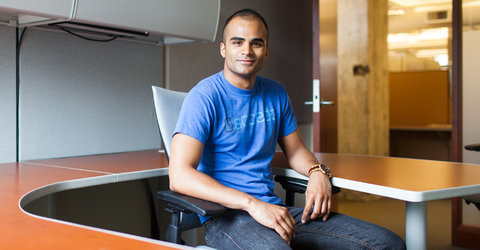 Matthew Ryan Williams for The New York Times Aseem Badshah has to decide which promising start-up to pursue.
Matthew Ryan Williams for The New York Times Aseem Badshah has to decide which promising start-up to pursue.
Case Study
What would you do with this business?
Last week, we published a case study about a young entrepreneur in Seattle, Aseem Badshah, who has been deciding how to divide his time and attention between two ventures.
His first business, Uptown Treehouse, creates online marketing campaigns to promote products for companies. Three years old, it earns an annual profit of more than $300,000 on annual revenue of $1.3 million. His new business, Socedo, scans social media and other Web sites to find sales leads for clients. Two hundred companies are already using a test version of the software, and Mr. Badshah has received positive feedback on it.
Now he needs to decide if he should spend all of his time on one of the businesses or split his time between the two. In last week’s article, we asked three experts to offer opinions, and they all gave different advice.
Dan J. Cunningham, chief executive of the Business Ferret, a financial and cash flow analysis consulting firm, suggested a conservative route, noting that Uptown Treehouse’s profits were established and healthy, while the risk of the new venture could leave Mr. Badshah with nothing. Steve Blank, an associate professor at Stanford University and co-author of “The Startup Owner’s Manual,” told Mr. Badshah to stick with one business or the other and put all his energies into it. Fred Dewey, a former chief executive of Kachingle and a co-founder and a partner at Emotional Intelligence at Work, recommended that Mr. Badshah divide his time between the two businesses.
Many readers agreed with Mr. Dewey. They said that finding a good team to run Uptown Treehouse and focusing there only when needed would help Mr. Badshah grow as a manager. Others pointed out that having a source of capital (Uptown Treehouse) for the new start-up (Socedo) was a rare luxury for an entrepreneur and could help Mr. Badshah negotiate from a stronger position with outside investors. And at only 24 years old, readers commented, Mr. Badshah has plenty of time to learn and try again if things don’t work out.
We contacted Mr. Badshah for a follow-up conversation that has been condensed and edited.
The three experts pointed you in different directions.
It was interesting that each of the three gave me completely different things to think about. That makes me think there is no right answer, and I should do what I believe is best in my particular situation.
What did you take from the reader comments?
There were a lot of different opinions, but no one said I should stop pursuing Socedo, even though it is a risky start-up. I felt a lot of encouragement from people telling me to “Go for it!” and to pursue what I was most excited about.
Does that mean you will try to keep both businesses going?
Yes, I am going to keep both but pause the search for Socedo funding. I had been flying around making presentations to outside investors, but I think my time is best spent working on the business itself and giving my energy to that. The Uptown Treehouse profits mean we don’t need outside money yet if we can operate in a really slim, low cost way. Plus, from initial feedback, we felt that we could get a better valuation later if we continued to leverage the Uptown Treehouse income to achieve more traction milestones with Socedo.
Can you do both?
I do have a strong team in Los Angeles led by my manager, Dillon Bianchi, and over the past six months they have brought on new clients and have continued to grow existing accounts while I have focused on Socedo. They have given me confidence that they can flourish without me and that I am doing the right thing by placing my confidence in them and pursuing both businesses.
Are there any synergies between the businesses?
Yes. The products of the two companies work together — one helps with sales and the other with marketing, so they are related. Lessons one team learns on what works or doesn’t work can help the other team. Also, when I do go to raise funds for Socedo, the fact that I have a proven business that has been running successfully for a few years helps my credibility as a C.E.O.
This post has been revised to reflect the following correction:
Correction: June 5, 2013
An earlier version of this article misstated the title of Fred Dewey at Emotional Intelligence at Work. He is a co-founder and a partner, not the chief executive.
Article source: http://boss.blogs.nytimes.com/2013/06/05/an-entrepreneur-chooses-potential-growth-over-proven-profits/?partner=rss&emc=rss